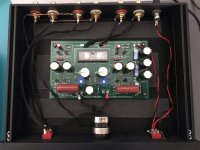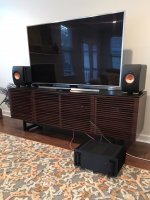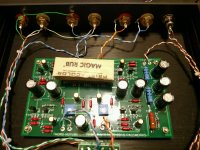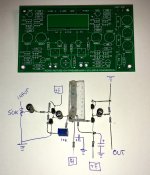Hi Frank,
As mentioned in the posts, the 2 first caps in the signal path are B1 Korg related and in no relation whatsoever with the following power amp. You CAN use 0.22uF for the first cap in the signal path, 1uF for the second, and that's regardless your set up or power amp.
The 3rd cap is indeed power amp related. IMHO you would struggle to find any power amp with an input impedance of less than 10k.That would be either an exotica with an unusual schematic or... a simply a very bad amp. So 3.3uF is already a quite safe value IMHO.
Usual values for power amp input impedance are between 20k and 100k, there used to be a practice of around 50k on many units but no rules on that..
As of bypassing existing caps, that's another topic with even more debates: I leave it to your experience and taste. ZM's idea is IMHO worth a try and indeed an easy one, anything down to 0.1uF "could" make sense... but that's not "for me" in this thread. I played with that on another thread very recently though...
Good luck
Claude
As mentioned in the posts, the 2 first caps in the signal path are B1 Korg related and in no relation whatsoever with the following power amp. You CAN use 0.22uF for the first cap in the signal path, 1uF for the second, and that's regardless your set up or power amp.
The 3rd cap is indeed power amp related. IMHO you would struggle to find any power amp with an input impedance of less than 10k.That would be either an exotica with an unusual schematic or... a simply a very bad amp. So 3.3uF is already a quite safe value IMHO.
Usual values for power amp input impedance are between 20k and 100k, there used to be a practice of around 50k on many units but no rules on that..
As of bypassing existing caps, that's another topic with even more debates: I leave it to your experience and taste. ZM's idea is IMHO worth a try and indeed an easy one, anything down to 0.1uF "could" make sense... but that's not "for me" in this thread. I played with that on another thread very recently though...
Good luck
Claude
use Silmic 10uF for each position and bypass each with 1uF solid cap of your choice
for anything better than that you'll need to pony up enormously
With my limited knowledge and wanting to make it easy on myself, I’m going to go the route suggested above by Zen Mod. I’ll order the parts soon and when I get them installed I’ll report back on my findings. Thanks to all who did your best to help this uninformed soul. Best regards.
Thanks for the reply soi, I never though about having each channel set differently I will give it a try. I don’t have any equipment so it will be by ear but that’s what counts.
Also reporting in on my build. I didn't think that I rushed through it but I guess I must have as I ended up with 2 mistakes that I was able to find and resolve today.
I actually finished the build a few weeks ago but there was an issue with the right channel as the nutube on that side barely lit up on initial power up, the voltage at TP 8 would only go up to @ 7 volts max and the channel had no output volume.
So I shelved it and finally I got it back on the bench today and started to go over all the connections, caps and resistor values/locations. After closer inspection I came across a fairly big mistake (at least for me). The cathode bypass cap on the right channel was installed backwards with the wrong polarity. Complete bonehead move on my part and just glad I didn't make that kind of mistake in the power section!
So I desoldered it (cap still tested good) and flipped it around and powered it back up and voltages for both channels were now to spec and the nutube lit up equally and nicely on both sides. I figured I was free and clear at this point, so I hooked it back up to my power amp but the right channel still had no volume. At this point I was beginning to worry that I may have damaged the nutube or another component when I installed the bypass cap backwards.
So I got it back up on the workbench and this time got out my signal generator and oscilloscope and started tracing the signal which came into the unit fine but vanished on the right channel at the pcb input. I scratched my head a few times and took a look again at the build doc photos only to realize I had the signal and ground wires switched around at the pot so full signal was getting dumped to ground on the right channel before it could make it to the pcb. A quick flip of the leads and finally signal magically showed up on the right channel output!
So the pre-amp is finally alive and works great! I can't wait to spend some time listening to it in my set up. I wasn't able to crank up the volume yet on my system but my initial impressions of it are very good.
It was fun build and great learning experience as this was the first time I've had multiple issues like this on a build that I was able to resolve on my own without having to seek further assistance here! 😀
I actually finished the build a few weeks ago but there was an issue with the right channel as the nutube on that side barely lit up on initial power up, the voltage at TP 8 would only go up to @ 7 volts max and the channel had no output volume.
So I shelved it and finally I got it back on the bench today and started to go over all the connections, caps and resistor values/locations. After closer inspection I came across a fairly big mistake (at least for me). The cathode bypass cap on the right channel was installed backwards with the wrong polarity. Complete bonehead move on my part and just glad I didn't make that kind of mistake in the power section!
So I desoldered it (cap still tested good) and flipped it around and powered it back up and voltages for both channels were now to spec and the nutube lit up equally and nicely on both sides. I figured I was free and clear at this point, so I hooked it back up to my power amp but the right channel still had no volume. At this point I was beginning to worry that I may have damaged the nutube or another component when I installed the bypass cap backwards.
So I got it back up on the workbench and this time got out my signal generator and oscilloscope and started tracing the signal which came into the unit fine but vanished on the right channel at the pcb input. I scratched my head a few times and took a look again at the build doc photos only to realize I had the signal and ground wires switched around at the pot so full signal was getting dumped to ground on the right channel before it could make it to the pcb. A quick flip of the leads and finally signal magically showed up on the right channel output!
So the pre-amp is finally alive and works great! I can't wait to spend some time listening to it in my set up. I wasn't able to crank up the volume yet on my system but my initial impressions of it are very good.
It was fun build and great learning experience as this was the first time I've had multiple issues like this on a build that I was able to resolve on my own without having to seek further assistance here! 😀
check input wiring , all the way from RCA to switch to pot to pcb
if needed , route RCA to pot directly, for test
if needed , route RCA to pot directly, for test
Is that true for both sets of inputs? At the risk of sounding ridiculous... Part of that check can be to ensure that your input selector switch is in the correct position for the inputs you are using. Check off the easiest potential cause first, it may save you some time (I hope). There are nasty rumors spreading that I may have cursed a bit due to that oversight on another build, but I'll deny it to the grave.  😀
😀
 😀
😀decsnspace,
I made the same mistake on my build with that 10uF capacitor. It's the only one of the six 10uF caps that face the other way around. Like you said, I felt a complete bonehead for making such a simple mistake. Thankfully I had spares to fix it.
Enjoy your music.
I made the same mistake on my build with that 10uF capacitor. It's the only one of the six 10uF caps that face the other way around. Like you said, I felt a complete bonehead for making such a simple mistake. Thankfully I had spares to fix it.
Enjoy your music.
@SuppersReady, Yeah getting the polarity right on caps and diodes is such a basic step of DIY electronics builds. I guess we're all human... Luckily the plus sign on the pcb was still visible next to the installed cap so it was a fairly easy catch upon closer inspection.
Sorry forgot to show photos earlier, looks much like everyone else’s.
You can see where i wired my Schiit Modi DAC direct for the time being. Also you might be able to see my power supply on an extension cord. The ps was causing a rapid ticking through the system so I found a quiet supply elsewhere in the room.
Still hoping someone can shed some light on the reading commented on in an earlier post. Thanks in advance.
Steve what did you cover your NuTube with? and does it work better than the eraser for the microphonics?
Arroww hi can’t say about the eraser I use blue tac you can find it in many places, Walmart, Staples, etc. Not sure if it’s genuine or if it matters. I use it to stick my speakers to the stands etc i also have balls of it under also the preamp.
Mould a package into a brick and stick it to the face of the tube. It has worked for me ,no trouble since.
Mould a package into a brick and stick it to the face of the tube. It has worked for me ,no trouble since.
Much appreciated, Blue Tack should resolve my problem that the eraser doesn't seem to completely fix.
Hi, a friend and I have talked about what if the Nutube where hard-wired.
So here I have done a test on what it can look like, a loooong way to finish. Get parts closer and nicer, the parts is just for test. No real value or something.
What do ya think, interesting or just madness and waiste of time?
Frank
So here I have done a test on what it can look like, a loooong way to finish. Get parts closer and nicer, the parts is just for test. No real value or something.
What do ya think, interesting or just madness and waiste of time?
Frank
Attachments
Yes, pure madness and waste of time. But to each its own....
There are many better ways to improve this preamplifier, not that the floating wiring would improve it in any ways.
Yves
There are many better ways to improve this preamplifier, not that the floating wiring would improve it in any ways.
Yves
Well I’ve finally sorted out the issues with my B1 Nutube preamp and replaced the Korg Nutube. I think it was a lightning strike earlier this year that damaged it. I have learned my lesson about keeping it on all the time in an area where we can have many thunderstorms.
I followed 6L6’s instructions on using double-plyed masking tape to serve as a temporary spacer when soldering in the Korg Nutube triode. Absolutely no problems with microphony—so I would definitely recommend this assembly technique.

Per ClaudeG’s recommendations, I replaced the input pair and middle pair of the 10uF electrolytic coupling caps with a pair of NOS 0.22uF Panasonic ECQP Polypropylene film and foil caps, and a pair of 2uF Axon True Cap metallized Polypropylene film caps. I replaced the output pair of 10uF electrolytic coupling caps with a pair of NOS 4.7uF Black Gate N non-polar electrolytic caps. Some here may consider this audiophoolery, but it sounds pretty awesome to my ears. I also installed a 50k Tocos Cosmos volume pot that was a nice change from the Alps Blue Velvet.
Anyway, I hauled my recently completed Aleph J to the living room to pair with my B1 Nutube preamp to drive my KEF LS50’s. My source is a Sony ES 4k Blu-ray/SACD/CD player. Wow! This is a phenomenal Pass DIY combination.

When properly set up with excellent amplification, these KEF monitors disappear and just leaves me enjoying the music. If you live the sound of tube amplification, but also want the best of solid state, this combination is pretty impressive.
I should also mention that my living room, kitchen and dining area are arranged in an open floor plan, so I am surprised it doesn’t take much to achieve room-filling volume. I thought with my KEF LS50’s, the impedance dip down to 3-4 ohms in the upper registers might be an issue, but the Aleph J sounds effortless and so natural.
I followed 6L6’s instructions on using double-plyed masking tape to serve as a temporary spacer when soldering in the Korg Nutube triode. Absolutely no problems with microphony—so I would definitely recommend this assembly technique.

Per ClaudeG’s recommendations, I replaced the input pair and middle pair of the 10uF electrolytic coupling caps with a pair of NOS 0.22uF Panasonic ECQP Polypropylene film and foil caps, and a pair of 2uF Axon True Cap metallized Polypropylene film caps. I replaced the output pair of 10uF electrolytic coupling caps with a pair of NOS 4.7uF Black Gate N non-polar electrolytic caps. Some here may consider this audiophoolery, but it sounds pretty awesome to my ears. I also installed a 50k Tocos Cosmos volume pot that was a nice change from the Alps Blue Velvet.
Anyway, I hauled my recently completed Aleph J to the living room to pair with my B1 Nutube preamp to drive my KEF LS50’s. My source is a Sony ES 4k Blu-ray/SACD/CD player. Wow! This is a phenomenal Pass DIY combination.

When properly set up with excellent amplification, these KEF monitors disappear and just leaves me enjoying the music. If you live the sound of tube amplification, but also want the best of solid state, this combination is pretty impressive.
I should also mention that my living room, kitchen and dining area are arranged in an open floor plan, so I am surprised it doesn’t take much to achieve room-filling volume. I thought with my KEF LS50’s, the impedance dip down to 3-4 ohms in the upper registers might be an issue, but the Aleph J sounds effortless and so natural.
Last edited:
I also think the B1 Korg and the Aleph J sound amazing together (with the B1 test points set at 10 volts). Great combo.
Have mine set at 10.5V.
KEF LS50’s aren’t known for their efficiency, but this combo had no problems driving them. Now I have to talk my wife into letting out these speakers on some nice heavy stands.
KEF LS50’s aren’t known for their efficiency, but this combo had no problems driving them. Now I have to talk my wife into letting out these speakers on some nice heavy stands.
Rich - nice build! Looks great.  Is that a PEC pot? What values did you use for the coupling capacitors?
Is that a PEC pot? What values did you use for the coupling capacitors?
Aleph J can run any low-impedance load you can throw at it, AJ just happily chugs along. 😀
 Is that a PEC pot? What values did you use for the coupling capacitors?
Is that a PEC pot? What values did you use for the coupling capacitors?Aleph J can run any low-impedance load you can throw at it, AJ just happily chugs along. 😀
- Home
- Amplifiers
- Pass Labs
- B1 with Korg Triode


